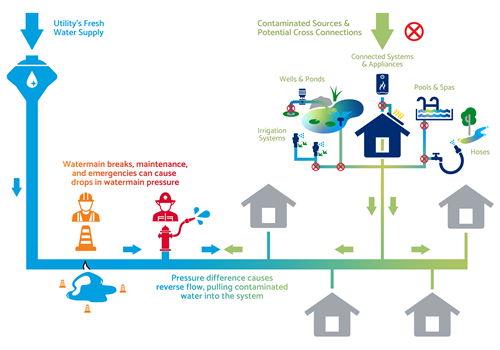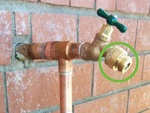Cross Connection & Backflow Prevention
Water systems depend on pressure to keep water flowing in the proper direction – from our watermains to your home or business. But a change in pressure can let contaminated water enter the public water supply if there is a cross connection with a non-potable water source within your plumbing system.
Cross Connection
A Cross Connection is a point in a water system where the potable water supply contacts a non-potable source. Non-potable sources are water in sinks, irrigation systems, washing machines, spas, swimming pools, solar systems, buckets, lawn puddles, hose bibs, and a wide range of commercial fixtures and machinery.
Water in these non-potable sources is considered contaminated, as they can contain biological and chemical contaminants. These can pose serious health risks if drawn back into the public water supply, and lead to costly damage to public water systems.
When there is a cross connection, a change in water pressure can create a backflow from a private plumbing system back to the public water supply. There are two types of backflows.
Backsiphonage
Backsiphonage can occur when a customer’s water pressure suddenly becomes greater than the watermain pressure. This might occur during a watermain or fire hydrant break, or system maintenance.
Backpressure
Backpressure can occur when a pressurizing device, such as a pump, is introduced into a plumbing system and water pressure becomes greater than the watermain pressure. This could occur with a pool, well, or pond pump.
Preventing cross connections and backflows requires: 1) avoiding possible cross connections, and 2) installing backflow prevention devices where needed and required by law.
The following video provides an overview of Cross Connection causes and prevention.
Preventing Cross Connections in the Home
These are the most common household cross connection hazards.

click to enlarge
Submerged Hoses
Hoses submerged in pools, spas, ponds, or other containers can act as conduits under backflow conditions. Try not to submerge hoses in water but keep them at a distance from the water’s surface. Remove hoses from containers once you’ve finished filling them. And don’t leave garden hoses lying on the ground, especially if there is no spray nozzle attached.
Pressure Sprayers and Washers
Equipment used for spraying lawn and garden chemicals and fertilizers, or pressure washers to which chemicals and detergents can be added, could release these contaminants back into the water system in a backflow event. Make sure they have the proper backflow prevention devices installed and working, and that you’re familiar with their use.
In-ground Irrigation Systems
In-ground irrigation systems often create puddles of standing water around the ground-level sprinkler heads. These heads are not designed to prevent backsiphonage. Make sure such systems have proper backflow prevention devices installed, ideally by a plumber or lawn care professional.
DIY Plumbing
Do-it-yourself household projects often seem risk-free, but just like electrical DIY, plumbing DIY carries risk to you and the public. Never use hoses to unplug blocked toilets or pipes, and never connect piping from water softeners or other treatment units to a sewer connection or submerged drainpipe. Ideally, leave plumbing installations and maintenance to a plumbing professional.
Backflow Prevention Devices for Your Home
In addition to simply avoiding cross connections, backflow prevention devices provide additional protection against backflow events. We strongly advise you contact us, or a plumbing professional, for help determining which type of device is best for your home and meets state and local requirements.
Hose Bib Vacuum Breakers
 Hose bib vacuum breakers are simple, low-cost plumbing devices that protect against backflow hazards when using hoses. They can be purchased at most hardware and lawn and garden stores and install in minutes.
Hose bib vacuum breakers are simple, low-cost plumbing devices that protect against backflow hazards when using hoses. They can be purchased at most hardware and lawn and garden stores and install in minutes.
When using a hose bib vacuum breaker, leave spray nozzles open after use, as the vacuum breaker won’t operate if the hose is left pressurized.
Appliance Backflow Prevention Devices
Appliances with permanent connections to your household plumbing (e.g., water heaters, water filtration systems, irrigation systems, swimming pools, spas, large aquariums) require backflow prevention devices suitable for that application and must be installed and maintained by a qualified plumber. They must also be protected against the dangers of freezing and thermal expansion.
Irrigation System Backflow Prevention Devices
All irrigation systems where cross connection potential exists must have an approved backflow prevention device/assembly that is proportionate with the degree of hazard.
High Health Hazard
Any irrigation system that has pumps or injectors for the addition of chemicals and/or fertilizers is considered a high health hazard. This risk assessment also considers outdoor bacterial contamination, if an auxiliary water supply (e.g., pond, cistern) is being used, and the ability of the operator to tamper with the system. In these cases, an approved RP or air gap separation is typically needed.
Moderate Health Hazard
Systems not classified as ‘high’ are considered ‘moderate’ health hazards. This risk assessment also considers outdoor bacterial contamination, and the ability of the operator to make changes to the system. In these systems, an approved double check valve assembly (DCVA), or pressure vacuum breaker assembly (PVBA), is normally recommended. However, a PVBA doesn’t provide adequate protection if it’s subjected to flooding, backpressure, has elevated piping, or if compressed air is used in winterization. In these systems, an approved DCVA is typically a minimum level of protection; however, in states where the International Plumbing Code (IPC) has been adopted, DCVA’s are not considered acceptable. The IPC requires an atmospheric-type vacuum breaker (no valves can be installed downstream), a PVBA or a RP, with the RP being the required means of protection if chemicals are used.
The American Water Works Association classifies all irrigation systems connected to a public water system as a cross connection risk, and a high health hazard, and recommends an air-gap separation or a reduced-pressure principle backflow prevention assembly (RP) as the appropriate means of protection.